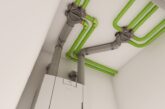
YBS Insulation provides a step-by-step guide to its SuperQuilt Trade multi-foil insulation in a pitched roof.
When it comes to insulation, not all options are created equal. Some are a breeze to work with, while others are a real hassle.
Take rock or mineral wool insulation, for instance. Yes, it offers great thermal performance, but the fibres can irritate your skin and lungs, meaning you need to suit up in gloves, masks, goggles during installation. Further, the dust and fibres can create a mess that demands a lot of clean up, driving up your time and labour costs.
Then there are insulation boards. They might get the job done, but they’re a logistical nightmare. Bulky and heavy, they’re tough to transport and even tougher to manoeuvre. Their rigidity is no friend to irregular spaces or obstacles like pipes and conduits, necessitating precise cuts with specialised tools and mechanical fasteners or adhesives which complicate installation. So, what’s the alternative?
Enter YBS SuperQuilt Trade, the no-nonsense, high-performing multi-foil insulation designed with the tradesperson in mind. This innovative insulation features leading thermal performance and a built-in vapour control membrane, all within a slim 40mm profile. SuperQuilt Trade’s unique layer composition provides a cost-effective and sustainable insulation solution – its 19 thermally efficient layers are as effective as 70mm of PIR when installed in between rafters, making it ideal for smaller spaces.
Flexible and easy to install, it offers great value for money, time and effort. No need for specialist tools or PPE – it’s lightweight and user-friendly, meaning just one skilled tradesperson can quickly handle an entire installation. YBS SuperQuilt Trade can be effortlessly rolled out, cut to size, and secured with staples or tape. Further, it doesn’t produce dust or fibres, resulting in a cleaner, safer work environment.
Six steps to installing YBS SuperQuilt Trade
YBS SuperQuilt Trade is a versatile insulation solution suitable for a wide range of applications, including pitched roofs, masonry walls, timber frame walls, floors, ceilings, and more. Here, we’ll provide a step-by-step guide to installing YBS SuperQuilt Trade multi-foil insulation in a pitched roof.
Step 1: Measure the length of the inner roof span
First, grab your tape measure to determine the distance of the inner span of the entire roof, from one end to the other, where you will be applying the insulation.

Step 2: Measure the insulation
Now roll out the insulation and measure it to the pre-determined length.

Step 3: Mark the insulation
Once you have your measurement, use a pen and ruler (or a flat piece of wood) to mark the cutting line on the insulation. Ensure the line is as precise as possible to match your measurement accurately.

Step 4: Cut the insulation
Next, cut the insulation to size along your marked line. You can use the YBS SuperQuilt cutter, a craft knife, or even a sharp pair of kitchen scissors to do this.

Step 5: Fix the insulation with staples
Lay the pre-cut length of SuperQuilt across the bottom of the rafters. Secure the insulation to the rafter at one end using staples at 300mm intervals, and then continue stapling to each rafter as you move across the roof span, ensuring it is pulled tight.
For best results, use 14mm stainless steel or galvanised staples.
Once you have completed securing the first row, move upward and install the next length. Please note that you must ensure that there is a minimum 50mm overlap between insulation pieces to maintain effective thermal performance.

Step 6: Seal the overlaps and perimeters
Finally, seal the overlaps and perimeters of the insulation with suitable aluminium tape, such as YBS Foil Tape, to ensure optimal heat retention. At the eaves where SuperQuilt is cut around the rafters, seal it to the cavity wall insulation or wall plate. Any exposed cut edges should also be sealed with YBS Foil Tape to prevent condensation.

A versatile solution
YBS SuperQuilt Insulation is not just effective for pitched roofs – its versatility makes it ideal for a range of applications, including masonry walls, timber frame walls, floors, ceilings, and more.
While the installation process is similar across different applications, there are specific considerations for each. In the case of masonry walls, for example, it is important to use timber battens to hold SuperQuilt in place and create a minimum 25mm air gap on both sides of the insulation for optimal performance. Here, cross battening is also recommended to minimise thermal bridging. Simply fix battens perpendicular to the rafters and seal them with YBS Foil Tape.
- Remember: Battens must always be fixed around the perimeter of windows. The plasterboard is fixed over the SuperQuilt and onto the battens in the usual manner. When installed below rafters, SuperQuilt will perform as a vapour barrier.
- Remember: When installing two layers of SuperQuilt, maintain a 38mm air gap between the layers to ensure effective insulation.
For more information on YBS Insulation visit www.ybsinsulation.com
If you would like to find out more about the manufacturer’s SuperQuilt Trade visit SuperQuilt Trade – YBS Insulation







